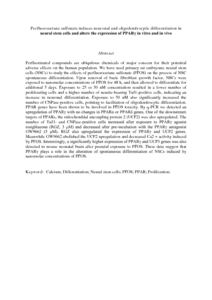Citation
Wan Ibrahim, Wan Norhamidah and Tofighi, Roshan and Onishchenko, Natalia and Rebellato, Paola and Bose, Raj and Uhlen, Per and Ceccatelli, Sandra
(2013)
Perfluorooctane sulfonate induces neuronal and oligodendrocytic differentiation in neural stem cells and alters the expression of PPARγ in vitro and in vivo.
Toxicology and Applied Pharmacology, 269 (1).
pp. 51-60.
ISSN 0041-008X; ESSN: 1096-0333
Abstract
Perfluorinated compounds are ubiquitous chemicals of major concern for their potential adverse effects on the human population. We have used primary rat embryonic neural stem cells (NSCs) to study the effects of perfluorooctane sulfonate (PFOS) on the process of NSC spontaneous differentiation. Upon removal of basic fibroblast growth factor, NSCs were exposed to nanomolar concentrations of PFOS for 48 h, and then allowed to differentiate for additional 5 days. Exposure to 25 or 50 nM concentration resulted in a lower number of proliferating cells and a higher number of neurite-bearing TuJ1-positive cells, indicating an increase in neuronal differentiation. Exposure to 50 nM also significantly increased the number of CNPase-positive cells, pointing to facilitation of oligodendrocytic differentiation. PPAR genes have been shown to be involved in PFOS toxicity. By q-PCR we detected an upregulation of PPARγ with no changes in PPARα or PPARδ genes. One of the downstream targets of PPARs, the mitochondrial uncoupling protein 2 (UCP2) was also upregulated. The number of TuJ1- and CNPase-positive cells increased after exposure to PPARγ agonist rosiglitazone (RGZ, 3 μM) and decreased after pre-incubation with the PPARγ antagonist GW9662 (5 μM). RGZ also upregulated the expression of PPARγ and UCP2 genes. Meanwhile GW9662 abolished the UCP2 upregulation and decreased Ca2 + activity induced by PFOS. Interestingly, a significantly higher expression of PPARγ and UCP3 genes was also detected in mouse neonatal brain after prenatal exposure to PFOS. These data suggest that PPARγ plays a role in the alteration of spontaneous differentiation of NSCs induced by nanomolar concentrations of PFOS.
Download File
![[img]](http://psasir.upm.edu.my/30227/1.hassmallThumbnailVersion/Perfluorooctane%20sulfonate%20induces%20neuronal%20and%20oligodendrocytic%20differentiation%20in%20neural%20stem%20cells%20and%20alters%20the%20expression%20of%20PPAR%CE%B3%20in%20vitro%20and%20in%20vivo.pdf)  Preview |
|
PDF (Abstract)
Perfluorooctane sulfonate induces neuronal and oligodendrocytic differentiation in neural stem cells and alters the expression of PPARγ in vitro and in vivo.pdf
Download (208kB)
| Preview
|
|
Additional Metadata
Actions (login required)
 |
View Item |

